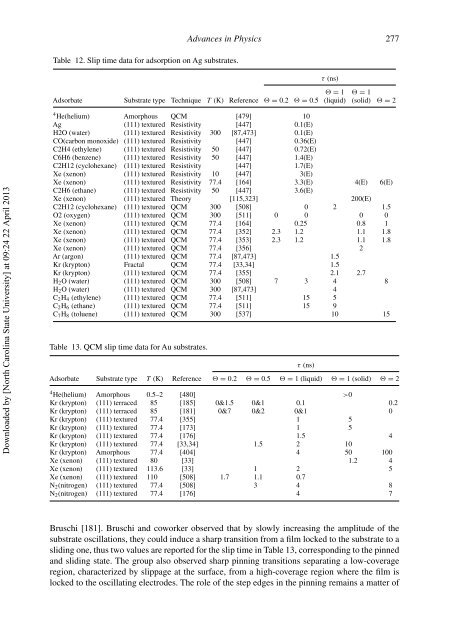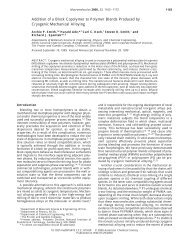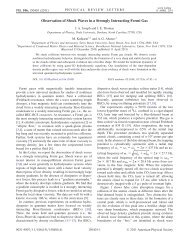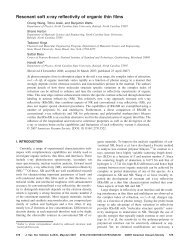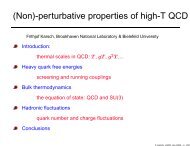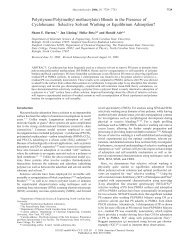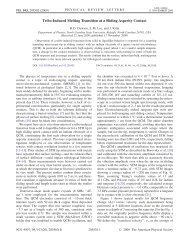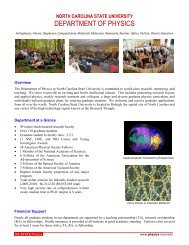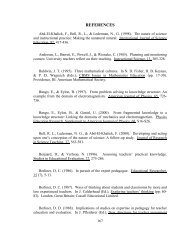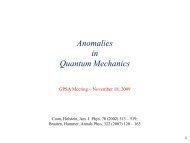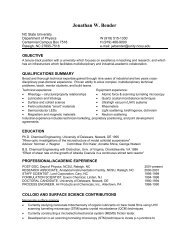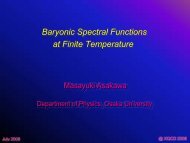Friction and energy dissipation mechanisms in adsorbed molecules ...
Friction and energy dissipation mechanisms in adsorbed molecules ...
Friction and energy dissipation mechanisms in adsorbed molecules ...
You also want an ePaper? Increase the reach of your titles
YUMPU automatically turns print PDFs into web optimized ePapers that Google loves.
Table 12. Slip time data for adsorption on Ag substrates.Advances <strong>in</strong> Physics 277 = 1 = 1Adsorbate Substrate type Technique T (K) Reference = 0.2 = 0.5 (liquid) (solid) = 2τ (ns)Downloaded by [North Carol<strong>in</strong>a State University] at 09:24 22 April 20134 He(helium) Amorphous QCM [479] 10Ag (111) textured Resistivity [447] 0.1(E)H2O (water) (111) textured Resistivity 300 [87,473] 0.1(E)CO(carbon monoxide) (111) textured Resistivity [447] 0.36(E)C2H4 (ethylene) (111) textured Resistivity 50 [447] 0.72(E)C6H6 (benzene) (111) textured Resistivity 50 [447] 1.4(E)C2H12 (cyclohexane) (111) textured Resistivity [447] 1.7(E)Xe (xenon) (111) textured Resistivity 10 [447] 3(E)Xe (xenon) (111) textured Resistivity 77.4 [164] 3.3(E) 4(E) 6(E)C2H6 (ethane) (111) textured Resistivity 50 [447] 3.6(E)Xe (xenon) (111) textured Theory [115,323] 200(E)C2H12 (cyclohexane) (111) textured QCM 300 [508] 0 2 1.5O2 (oxygen) (111) textured QCM 300 [511] 0 0 0 0Xe (xenon) (111) textured QCM 77.4 [164] 0.25 0.8 1Xe (xenon) (111) textured QCM 77.4 [352] 2.3 1.2 1.1 1.8Xe (xenon) (111) textured QCM 77.4 [353] 2.3 1.2 1.1 1.8Xe (xenon) (111) textured QCM 77.4 [356] 2Ar (argon) (111) textured QCM 77.4 [87,473] 1.5Kr (krypton) Fractal QCM 77.4 [33,34] 1.5Kr (krypton) (111) textured QCM 77.4 [355] 2.1 2.7H 2 O (water) (111) textured QCM 300 [508] 7 3 4 8H 2 O (water) (111) textured QCM 300 [87,473] 4C 2 H 4 (ethylene) (111) textured QCM 77.4 [511] 15 5C 2 H 6 (ethane) (111) textured QCM 77.4 [511] 15 9C 7 H 8 (toluene) (111) textured QCM 300 [537] 10 15Table 13. QCM slip time data for Au substrates.Adsorbate Substrate type T (K) Reference = 0.2 = 0.5 = 1 (liquid) = 1 (solid) = 24 He(helium) Amorphous 0.5–2 [480] >0Kr (krypton) (111) terraced 85 [185] 0&1.5 0&1 0.1 0.2Kr (krypton) (111) terraced 85 [181] 0&7 0&2 0&1 0Kr (krypton) (111) textured 77.4 [355] 1 5Kr (krypton) (111) textured 77.4 [173] 1 5Kr (krypton) (111) textured 77.4 [176] 1.5 4Kr (krypton) (111) textured 77.4 [33,34] 1.5 2 10Kr (krypton) Amorphous 77.4 [404] 4 50 100Xe (xenon) (111) textured 80 [33] 1.2 4Xe (xenon) (111) textured 113.6 [33] 1 2 5Xe (xenon) (111) textured 110 [508] 1.7 1.1 0.7N 2 (nitrogen) (111) textured 77.4 [508] 3 4 8N 2 (nitrogen) (111) textured 77.4 [176] 4 7τ (ns)Bruschi [181]. Bruschi <strong>and</strong> coworker observed that by slowly <strong>in</strong>creas<strong>in</strong>g the amplitude of thesubstrate oscillations, they could <strong>in</strong>duce a sharp transition from a film locked to the substrate to aslid<strong>in</strong>g one, thus two values are reported for the slip time <strong>in</strong> Table 13, correspond<strong>in</strong>g to the p<strong>in</strong>ned<strong>and</strong> slid<strong>in</strong>g state. The group also observed sharp p<strong>in</strong>n<strong>in</strong>g transitions separat<strong>in</strong>g a low-coverageregion, characterized by slippage at the surface, from a high-coverage region where the film islocked to the oscillat<strong>in</strong>g electrodes. The role of the step edges <strong>in</strong> the p<strong>in</strong>n<strong>in</strong>g rema<strong>in</strong>s a matter of


